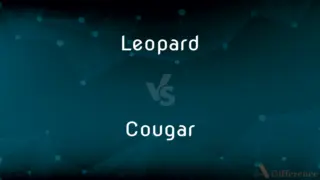Esker vs. Drumlin — What's the Difference?
By Fiza Rafique & Urooj Arif — Updated on March 22, 2024
Eskers are long, winding ridges of sand and gravel formed by retreating glaciers, while drumlins are streamlined, oval-shaped hills composed of glacial till.

Difference Between Esker and Drumlin
Table of Contents
ADVERTISEMENT
Key Differences
Eskers form from sediment deposition within subglacial or englacial streams, creating elongated, sometimes snaking ridges that can extend for miles. These ridges are typically found in previously glaciated regions, marking the path of meltwater streams beneath or within glaciers. On the other hand, drumlins are shaped by the movement of glaciers over an underlying substrate, with their long axis aligned in the direction of ice flow. They are made primarily of till, a mixture of clay, silt, sand, and gravel that was deposited directly by glacier ice.
Eskers are notable for their linear form, which can provide insight into the direction of glacial meltwater flow. Their formation requires a steady supply of meltwater, making their presence an indicator of past glacial activity and the dynamics of ice retreat. Drumlin fields, or groups of drumlins, can indicate the flow direction of ice sheets and are often found in clusters, revealing patterns of ice movement across the landscape.
The study of eskers and drumlins contributes to our understanding of glacial processes and the shaping of Earth's surface. Eskers, with their confined routes of formation, tell a story of water flow beneath ice, while drumlins give clues about the overarching movement of glaciers themselves, offering a larger-scale perspective on glacial dynamics.
While eskers serve as a record of subglacial water paths, drumlins provide evidence of the glacier's shape and movement, reflecting different aspects of glacial behavior. Their distinct forms and compositions are key to reconstructing past glacial environments and understanding the geological history of an area.
Comparison Chart
Composition
Sand and gravel
Glacial till (clay, silt, sand, gravel)
ADVERTISEMENT
Shape
Long, winding ridges
Streamlined, oval-shaped hills
Formation Process
Sediment deposition in meltwater streams
Shaping by glacial movement over substrate
Indicative of
Direction of glacial meltwater flow
Direction of glacier flow
Location
Previously glaciated regions
Clusters in glaciated landscapes
Compare with Definitions
Esker
A long, narrow ridge of gravel and sand deposited by meltwater streams flowing beneath a glacier.
The esker snaked through the valley, a remnant of the last Ice Age.
Drumlin
Drumlins are specific types of glacial deposits with a distinct shape.
The glacial deposit we studied was identified as a drumlin, indicating past ice flow directions.
Esker
Eskers are composed of sediment sorted and deposited by flowing water.
The sediment deposit forming the esker was rich in sand and gravel.
Drumlin
A streamlined, elongated hill formed by glacial action, composed mostly of till.
The field was dotted with drumlins, left behind by the retreating ice sheet.
Esker
Eskers serve as indicators of glacial movement and meltwater direction.
Geologists studied the esker as a clue to the glacier's retreat path.
Drumlin
Drumlin material, a mix of clay, silt, sand, and gravel, deposited by glaciers.
The drumlin was comprised of glacial till, packed tightly by ice pressure.
Esker
Eskers are distinct landforms created by glacial processes.
The glacial landform we hiked along was an impressive esker, extending miles across the landscape.
Drumlin
Drumlins provide clues to the direction of past glacier movement.
The orientation of drumlins across the landscape indicated the ice flow direction.
Esker
Eskers form beneath the ice, tracing the path of meltwater tunnels.
The subglacial feature revealed by the receding glacier was an extensive esker.
Drumlin
Drumlins are hills shaped directly by the movement of glacier ice.
Each ice-shaped hill in the area was a drumlin, aligned with the glacier's flow.
Esker
An esker, eskar, eschar, or os, sometimes called an asar, osar, or serpent kame, is a long, winding ridge of stratified sand and gravel, examples of which occur in glaciated and formerly glaciated regions of Europe and North America. Eskers are frequently several kilometres long and, because of their uniform shape, look like railway embankments.
Drumlin
A drumlin, from the Irish word droimnín ("littlest ridge"), first recorded in 1833, in the classical sense is an elongated hill in the shape of an inverted spoon or half-buried egg formed by glacial ice acting on underlying unconsolidated till or ground moraine. Assemblages of drumlins are referred to as fields or swarms; they can create a landscape which is often described as having a 'basket of eggs topography'.
Esker
A long, narrow, steep-sided ridge of coarse sand and gravel deposited by a stream flowing in or under a melting sheet of glacial ice. Also called os3.
Drumlin
An elongated hill or ridge of glacial drift.
Esker
A long, narrow, sinuous ridge created by deposits from a stream running beneath a glacier.
Drumlin
(geography) An elongated hill or ridge of glacial drift.
Esker
(geology) a long winding ridge of post glacial gravel and other sediment; deposited by meltwater from glaciers or ice sheets
Drumlin
A hill of compact, unstratified, glacial drift or till, usually elongate or oval, with the larger axis parallel to the former local glacial motion.
Drumlin
A mound of glacial drift
Common Curiosities
How do eskers form?
Eskers form from the deposition of sand and gravel by meltwater streams flowing beneath or within glaciers.
What materials make up a drumlin?
Drumlins are primarily made of glacial till, a mixture of clay, silt, sand, and gravel deposited by glaciers.
What is the significance of drumlins' shape?
The streamlined shape of drumlins indicates the direction of glacier movement, with their long axis aligned with the ice flow.
Are eskers longer than drumlins?
Eskers can be several miles long, typically longer than individual drumlins, due to their formation along meltwater streams.
What is the role of meltwater in forming eskers?
Meltwater plays a crucial role in esker formation, as it transports and deposits sediment in tunnels beneath the ice.
What do eskers indicate about past glaciers?
Eskers indicate the direction of meltwater flow beneath glaciers, offering clues to the dynamics of glacial retreat.
Can the presence of drumlins affect the landscape?
Yes, drumlins influence the landscape by directing water flow and providing a foundation for soil and vegetation.
How do geologists use drumlins to study glaciers?
Geologists study drumlin fields to understand the direction and behavior of past glacier movements.
What are eskers and drumlins?
Eskers are ridges formed by sediment deposited by meltwater streams beneath glaciers, while drumlins are streamlined hills made of glacial till shaped by moving glaciers.
Can eskers and drumlins be found together?
While they can occur in the same glaciated region, eskers and drumlins form under different conditions and are not typically found together.
Are eskers unique to certain regions?
Eskers are primarily found in regions that were covered by glaciers during the last Ice Age, making them unique to certain geographical areas.
Why are drumlins often found in clusters?
Drumlins form under the glacier's ice, resulting in groups of these hills as the ice advances and shapes the landscape.
What distinguishes eskers from other glacial features?
Eskers are distinguished by their linear, ridge-like form and sediment composition, differing from other glacial features like moraines or kettle lakes.
How do drumlins form from glacial till?
Drumlins form when glaciers move over an area, compacting and shaping the till into streamlined hills.
Share Your Discovery

Previous Comparison
Leopard vs. Cougar
Next Comparison
Endocrinology vs. GastroenterologyAuthor Spotlight
Written by
Fiza RafiqueFiza Rafique is a skilled content writer at AskDifference.com, where she meticulously refines and enhances written pieces. Drawing from her vast editorial expertise, Fiza ensures clarity, accuracy, and precision in every article. Passionate about language, she continually seeks to elevate the quality of content for readers worldwide.
Co-written by
Urooj ArifUrooj is a skilled content writer at Ask Difference, known for her exceptional ability to simplify complex topics into engaging and informative content. With a passion for research and a flair for clear, concise writing, she consistently delivers articles that resonate with our diverse audience.
















































